Fermented pickles are a treat loaded with probiotics and a delicious sour pickle taste. These are the original, old-school, traditional, deli-style pickles that are nostalgic for many people. Fermented pickles are the real deal, are easy to make, and are rooted in lacto-fermented history!
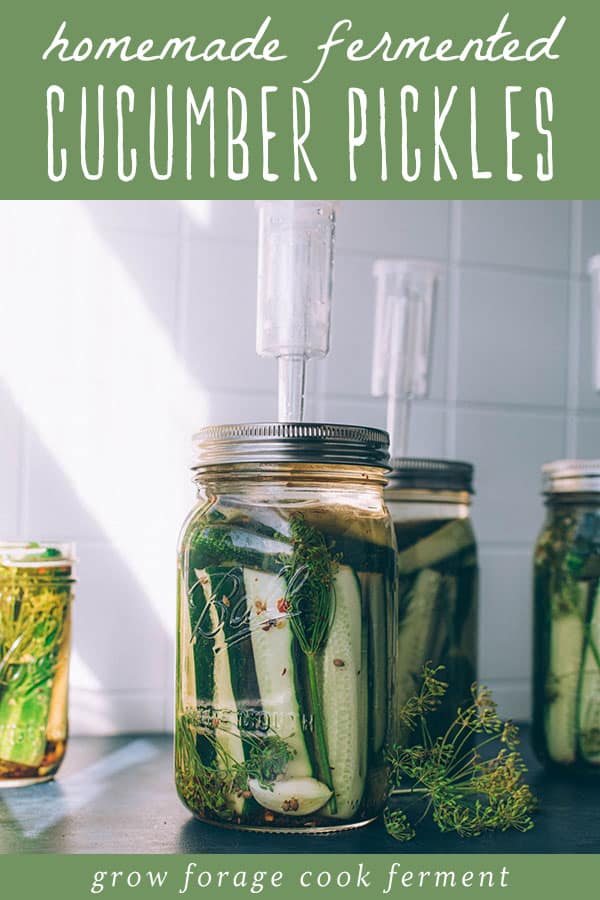
Want to save this post for later?
What’s the Difference Between Fermented Pickles and Regular Pickles?
I absolutely love fermented cucumber pickles, they were probably what initially got me into fermenting, to begin with. I’ve been a pickle lover ever since I was a kid, and love all varieties, including canned vinegar pickles, refrigerator bread and butter pickles, and dill pickles.
The main difference is that fermented pickles use saltwater brine and time to ferment, while other varieties are soaked and pickled in a vinegar solution and canned to be shelf stable.
My mom makes awesome sweet bread and butter pickles, and her dill pickles are to die for, but there is something to be said for traditionally fermented cucumber pickles. They have that authentic deli taste that I crave, and they are super easy to make!
This is hands down the best way to make pickles, and it is truly a historical way to do it – fermenting is the original way to preserve foods so I feel like I’m getting back to my roots any time I ferment!
Related: How to Preserve Cucumbers: Ferment, Can, Freeze and More!
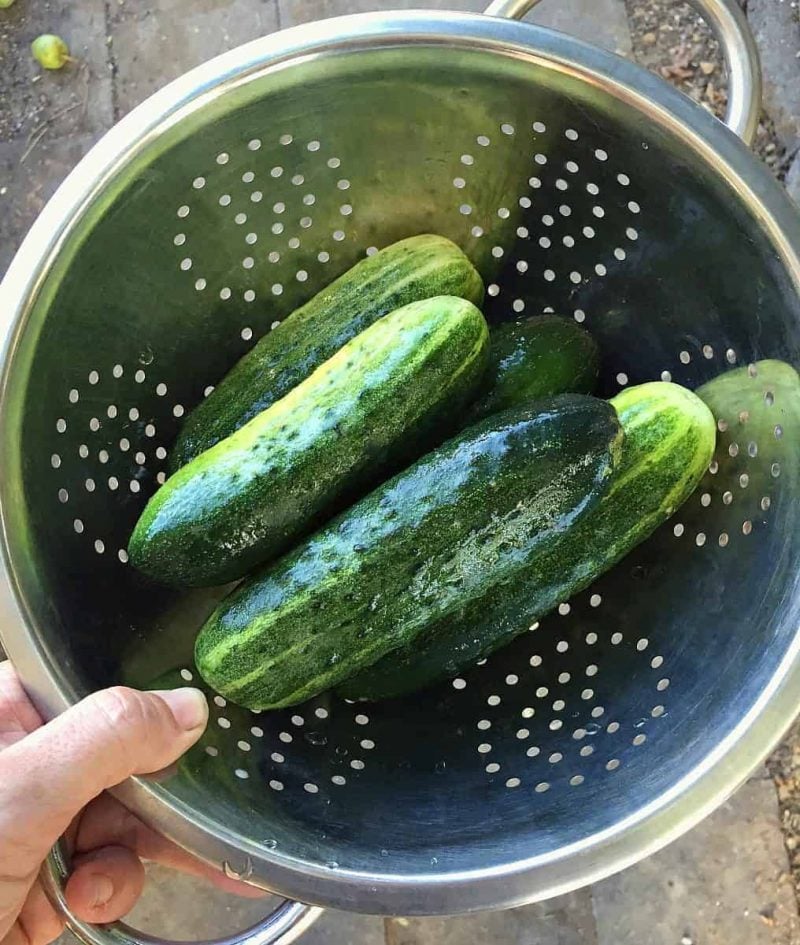
Get more recipes for canning, fermenting, quick pickling, dehydrating, and freezing so that you can enjoy your summer produce year-round in my ebook Preserving the Garden Harvest!
Cucumbers for Fermenting
I suppose what prompted this post is that my local natural food co-op had these amazing-looking pickling cucumbers in stock.
I’m growing my own cucumbers to pickle, but they won’t be ready for a good while. I figured I’d get ahead of the game and make some fermented cucumber pickles now while I had the opportunity!
Pickling cucumbers work best in this recipe, as they are less seedy and watery than regular slicing cucumbers. They are also the best choice for making kosher dill pickles, which are canned and not fermented.
How to Make Fermented Cucumber Pickles
Ingredients
- Pickling salt or sea salt – make sure you don’t use iodized salt.
- 1 quart of water – unchlorinated water is important since chlorine will disrupt the fermentation process, so filtered or bottled water is best.
- Pickling cucumbers – You can use other types of cucumbers, but regular pickling ones are best!
- Whole fresh dill flowers – or dried dill seeds.
- Fresh garlic – for the absolute best garlicky taste!
- Pickling spices – use your favorites: peppercorns, mustard seeds, coriander seeds, and red pepper flakes. A pickling spice blend works great too if preferred.
This recipe will make 2 quarts of pickles. The number of cucumbers to use will vary depending on their size. As you can see, this recipe is very customizable, so make your pickles how you like them!
Ferment the Pickles
First, make the brine by combining the water and salt in a pitcher or jar and stirring until the salt is dissolved.
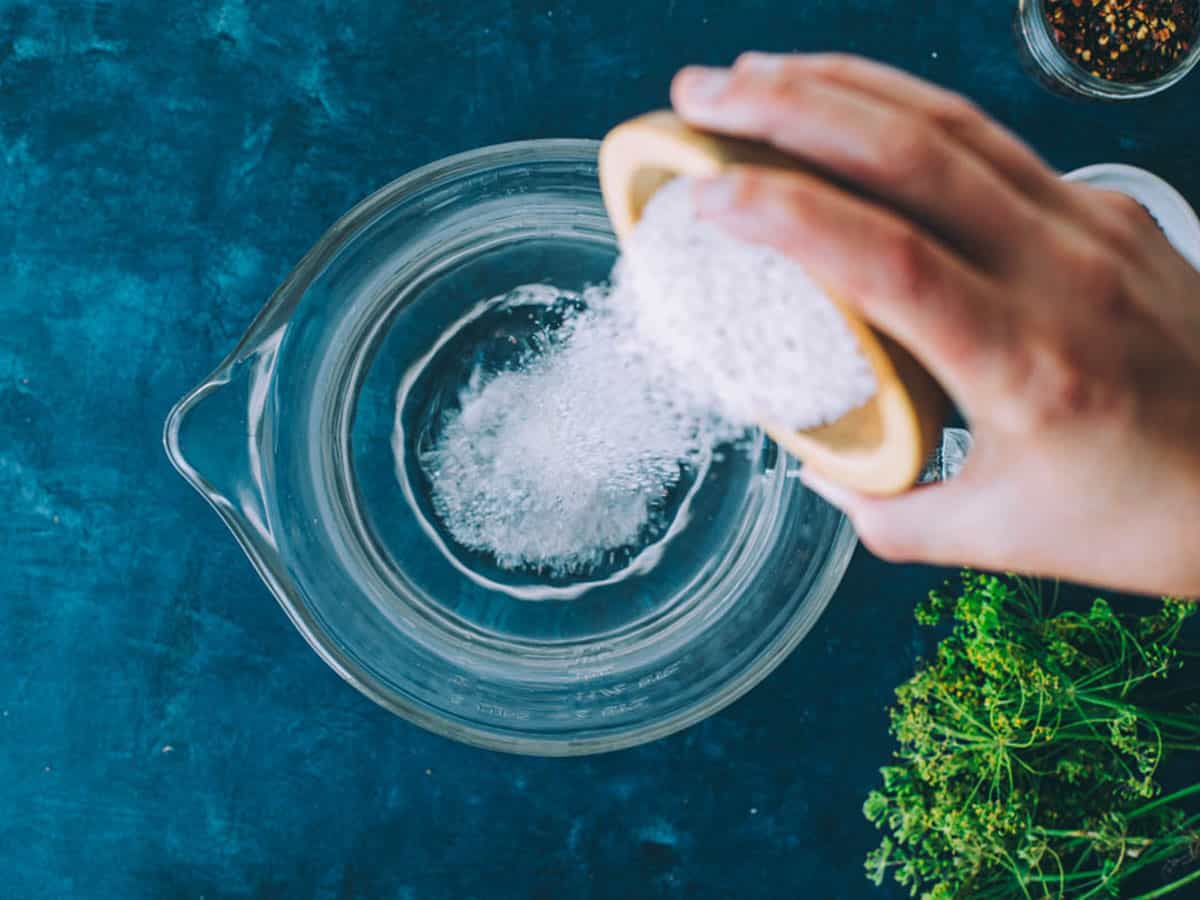
Then divide the dill, garlic, and spices into two 1-quart jars.
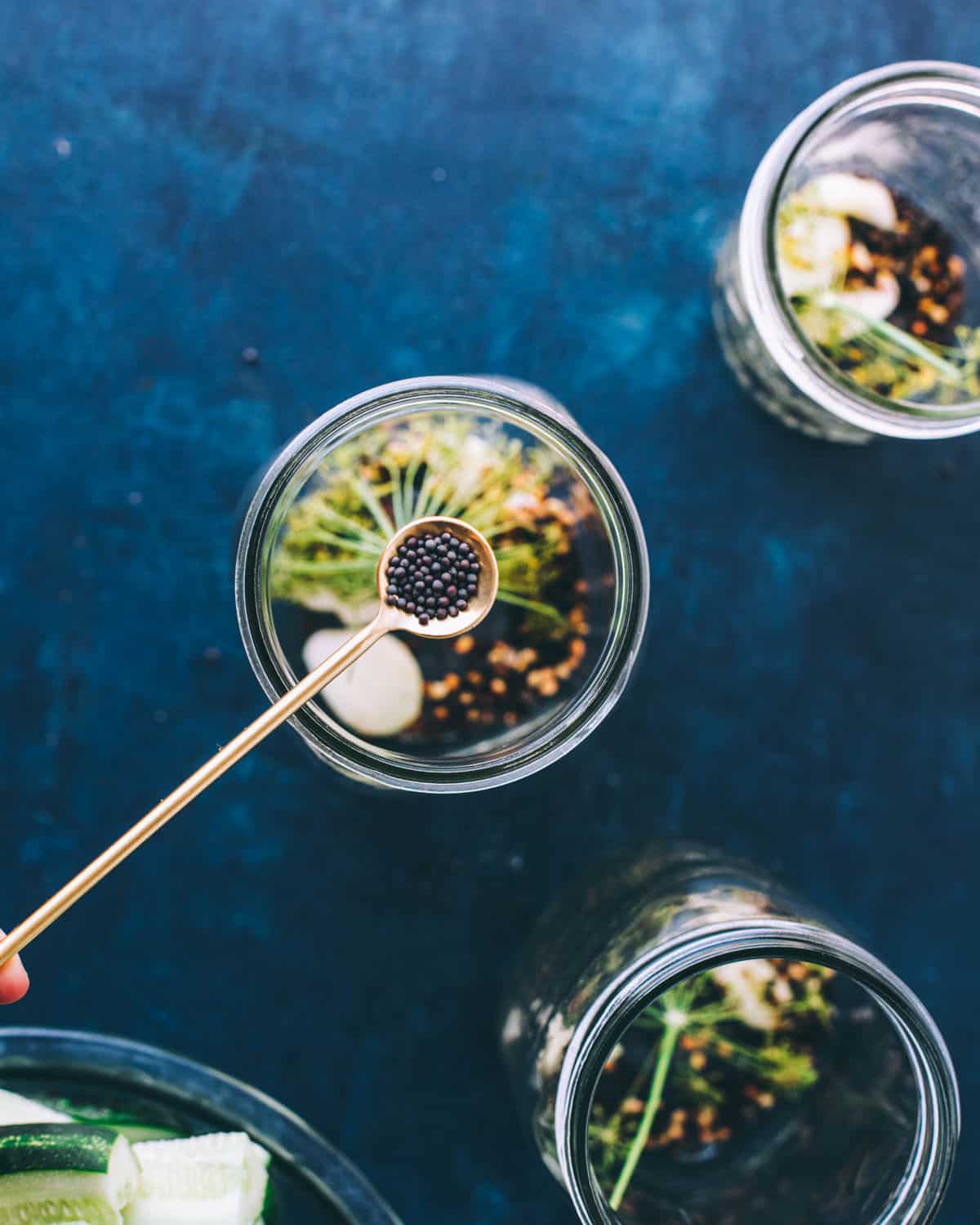
Cut both ends off of the cucumbers and cut them into spears. Add as many cucumber spears into the jars with the spices as can fit. The more the merrier!
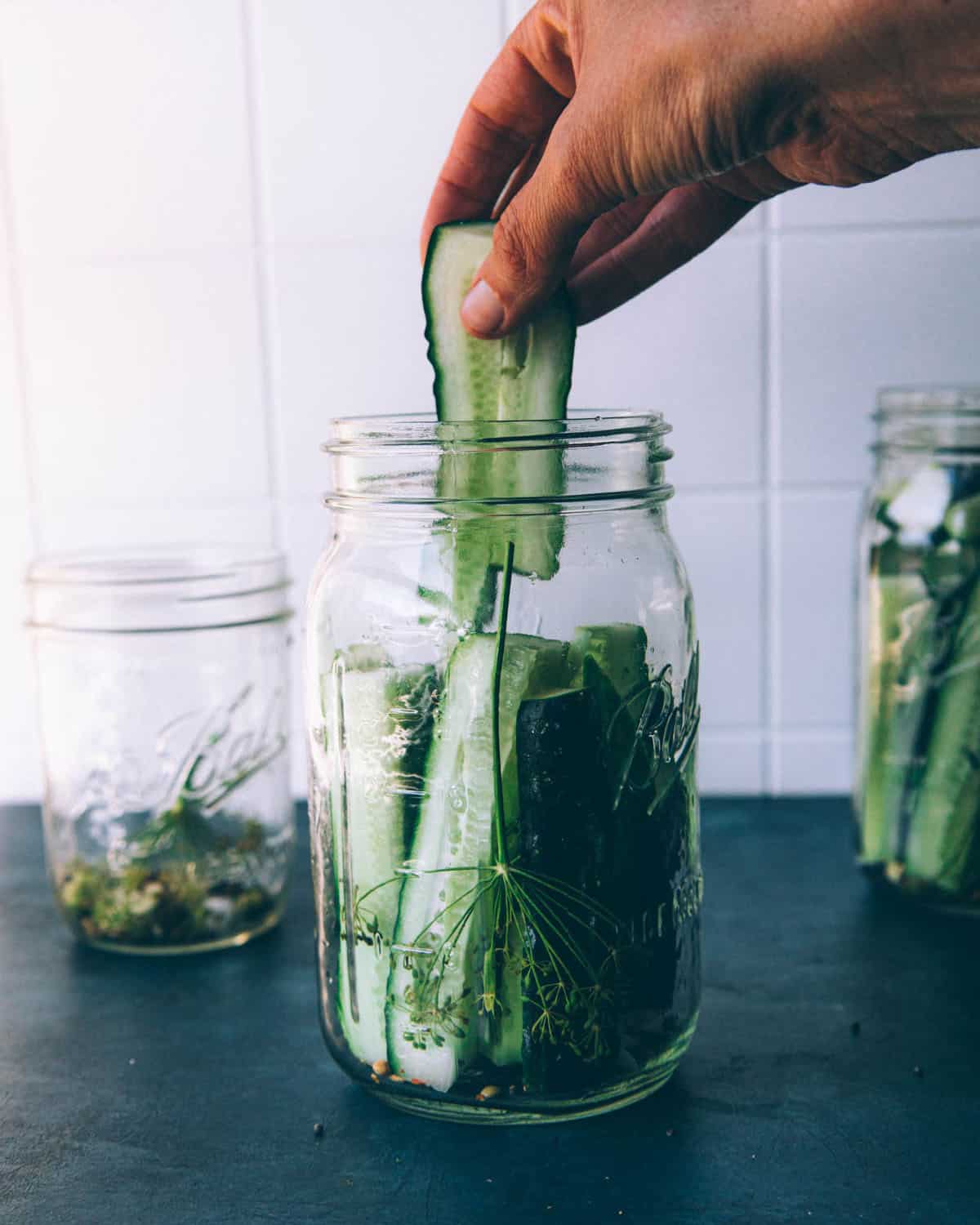
Fill the jars with the saltwater brine, leaving an inch of headspace.
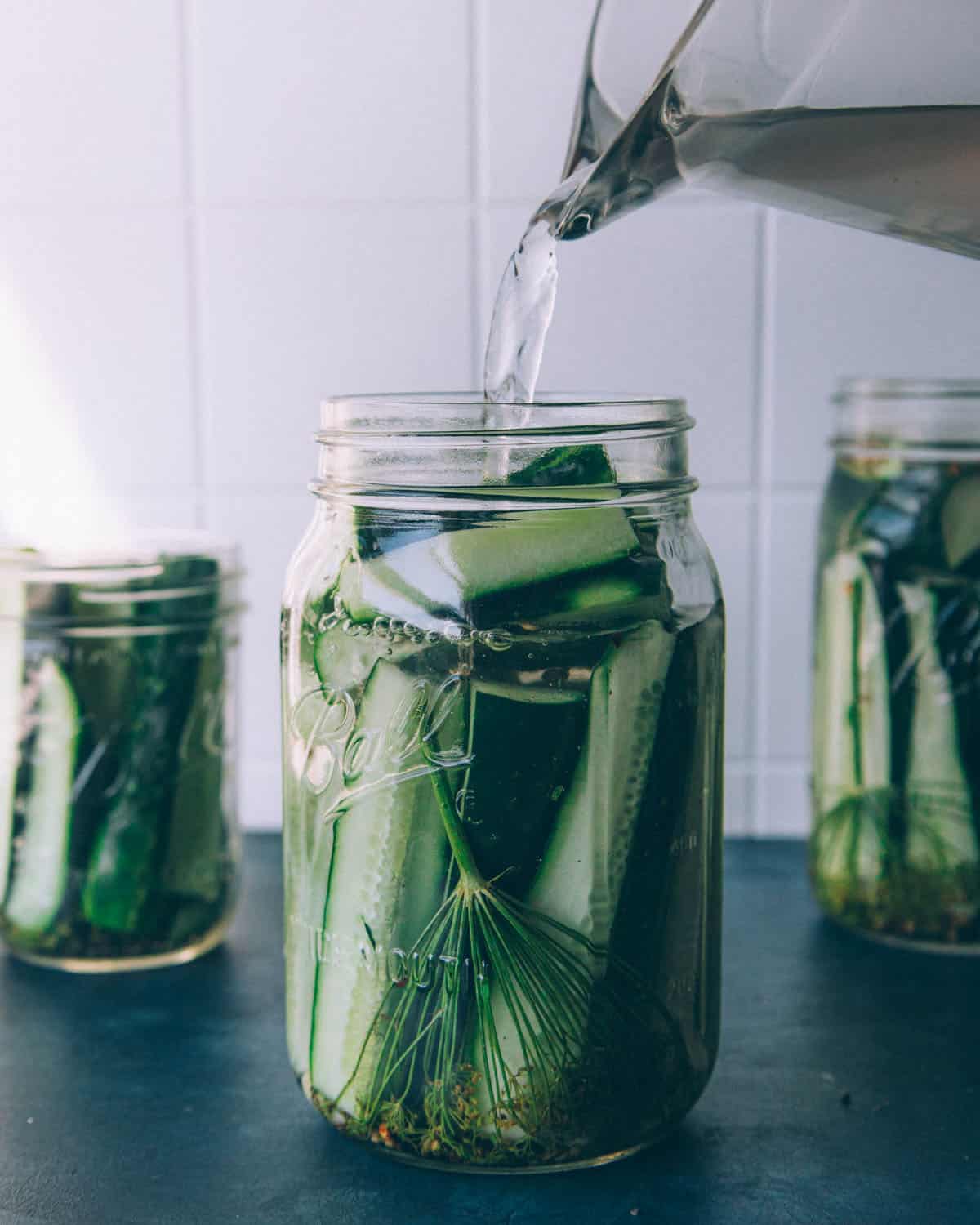
Use a fermentation weight to keep your cucumbers under the brine, and cap it with an airlock lid.
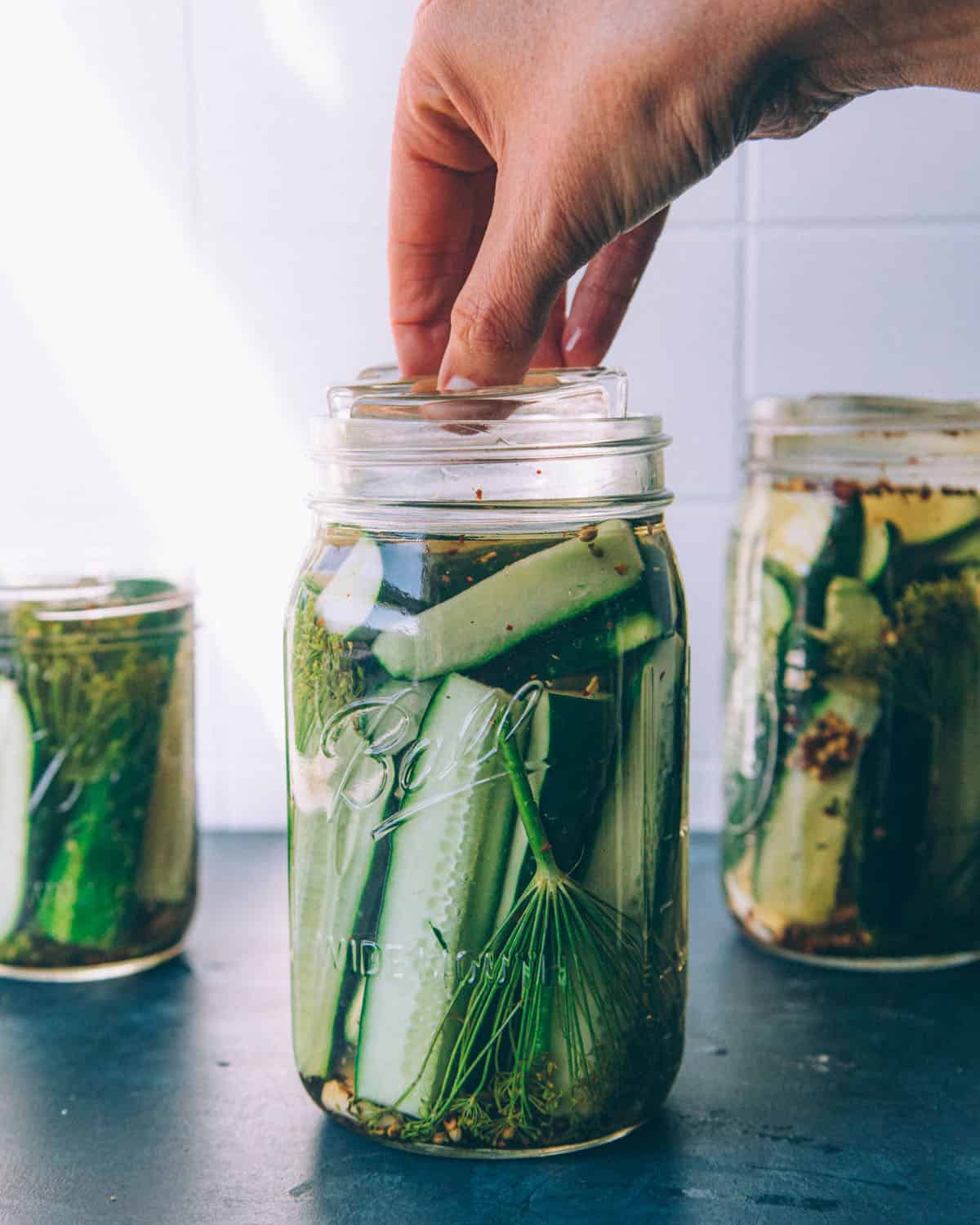
I will often use a super clean smaller jar filled with water as a weight, covered with a kitchen towel to keep dirt and bugs out, so that is an alternative if you don’t have fermentation weights and lids.
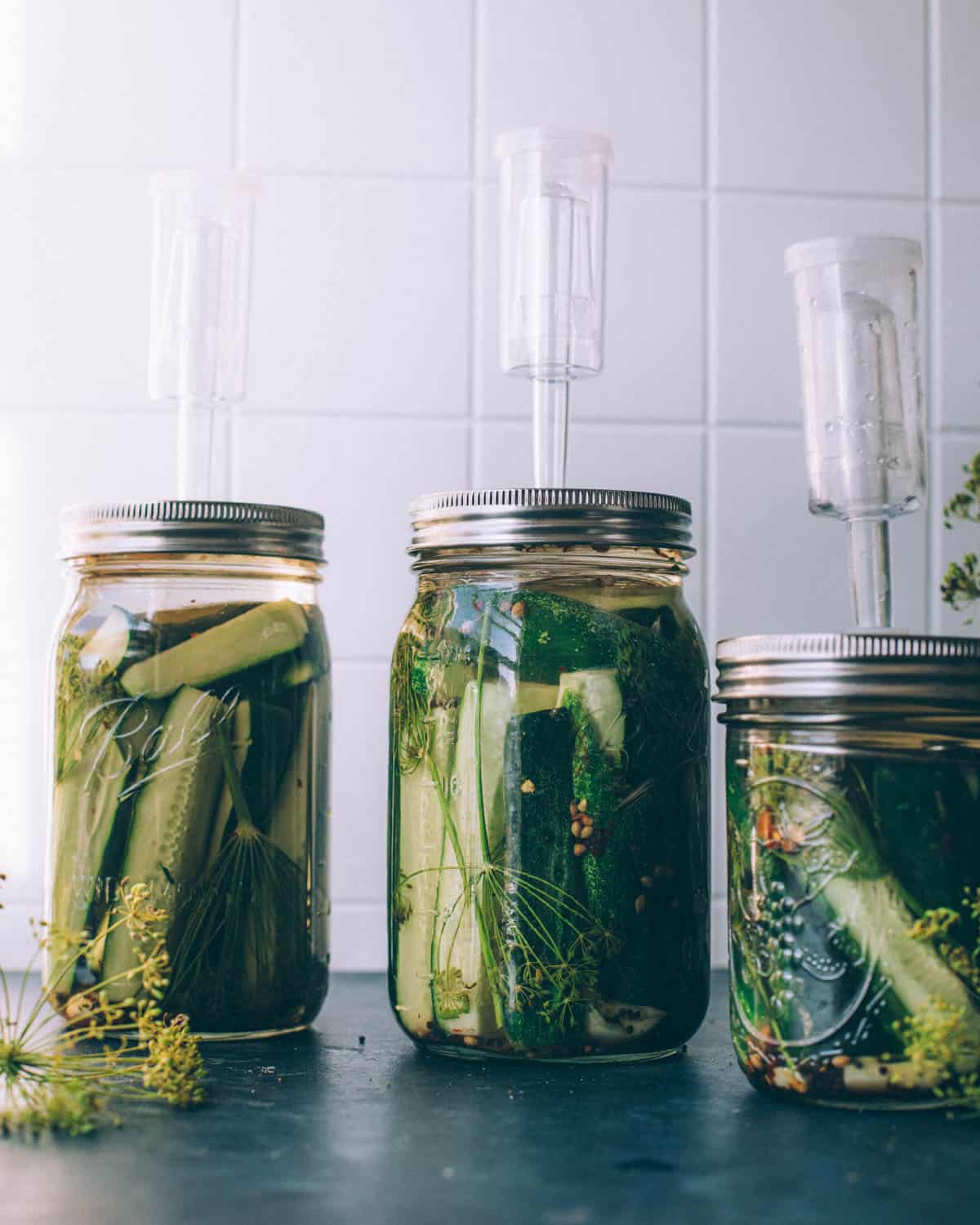
Put the jars in a cool place out of direct sunlight.
If you’re using the smaller jar weight method, put them on a plate as there may be a bit of brine leakage as the cucumbers extract some of their liquid.
Check the jars every few days to see how they’re doing.
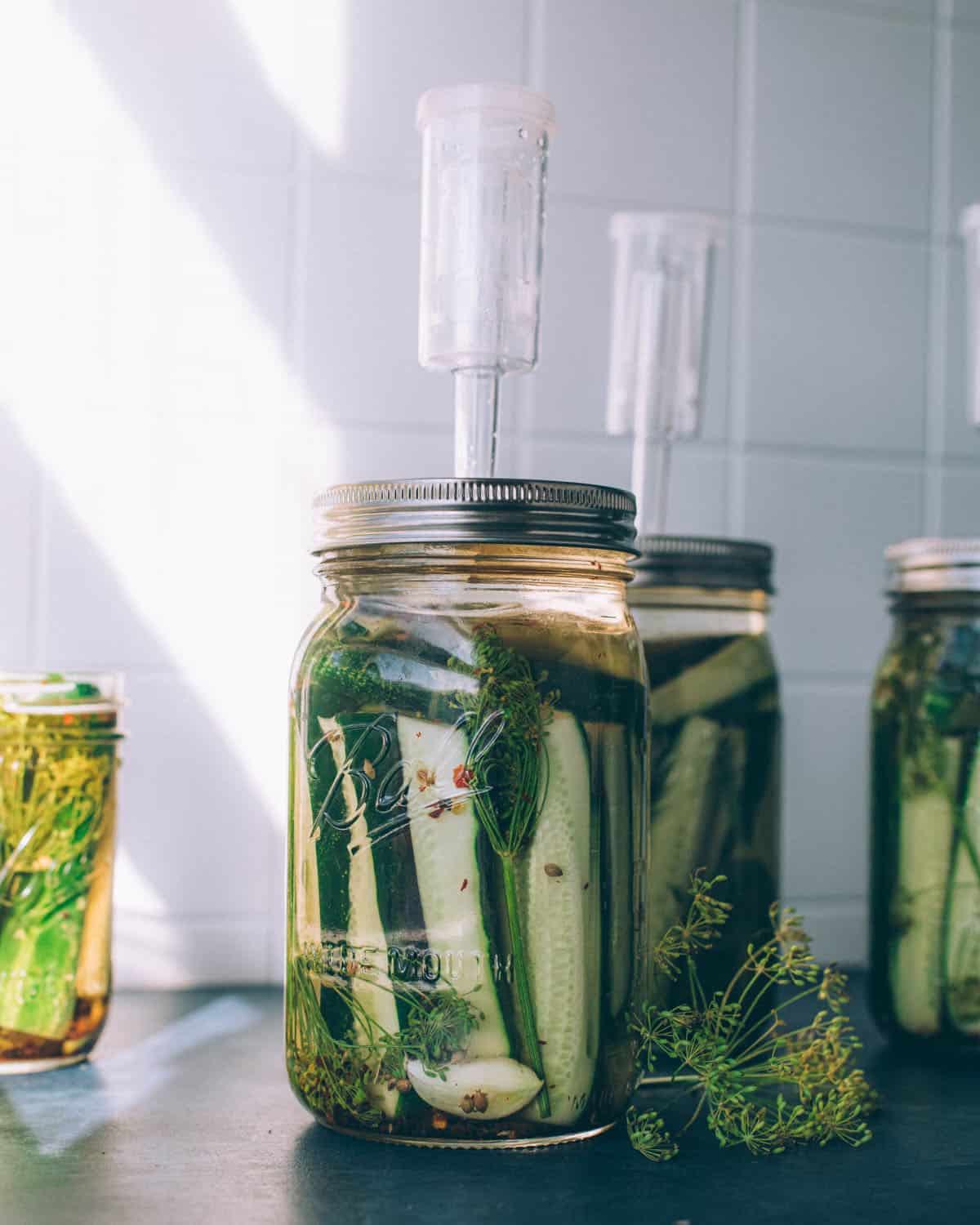
A good way to know your fermented pickles are finished is when they are paler green in color and a bit softer, but not mushy. In general, it’s about 3-6 days, but can vary with the ambient temperature and other factors.
Give one a taste if you’re unsure, and once they taste how you like them, then they are done! If they don’t quite have that traditional deli-style taste you want, keep fermenting them until they do.
Then you can revel in pickle-y goodness!
These are so tasty, they don’t last very long at my house. You gotta get ’em while they’re hot!
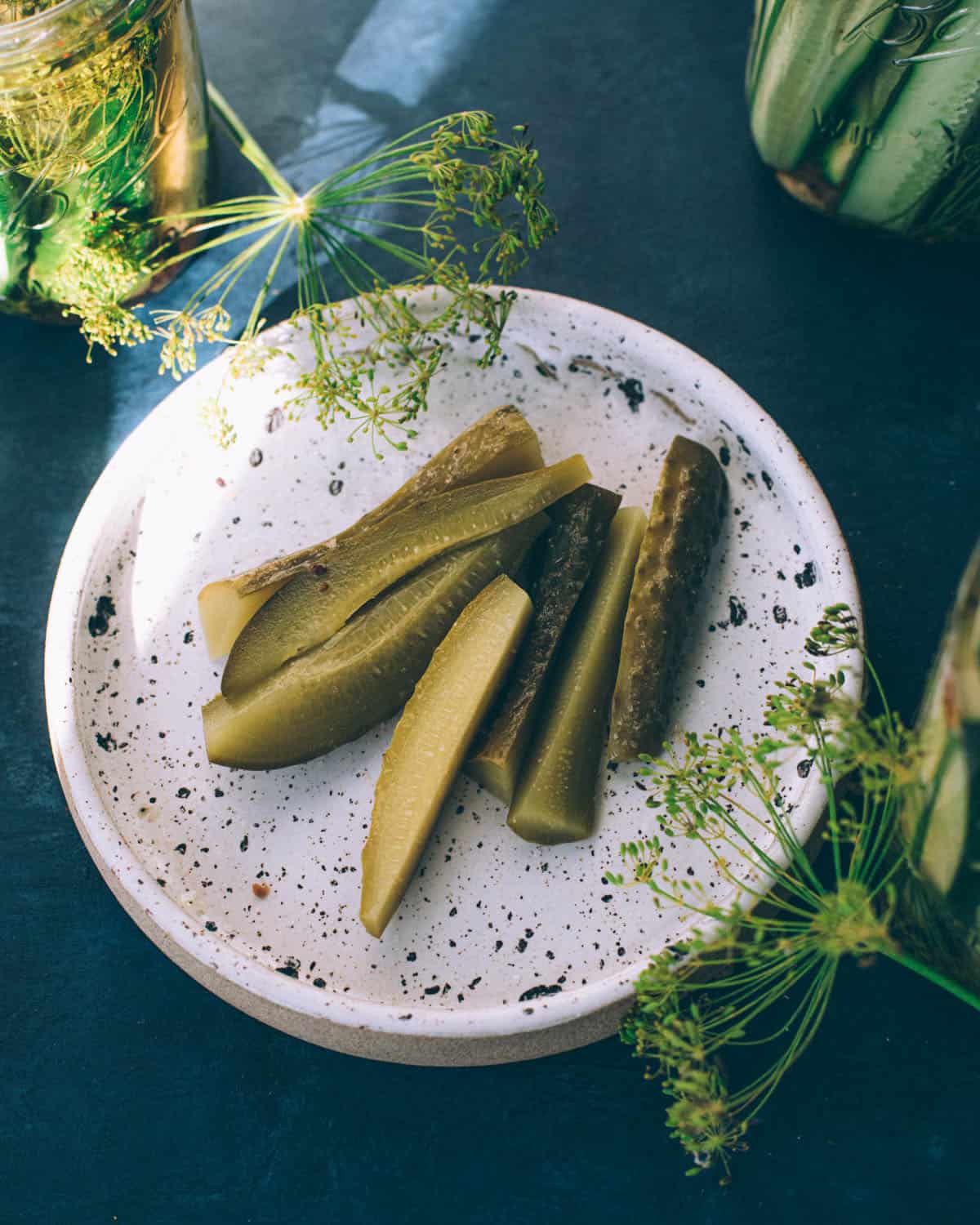
How Long do Fermented Pickles Last?
To store fermented cucumber pickles once they’re done fermenting, take off the airlock cap, close with a regular lid, and store in the refrigerator.
Once fermented, these pickles can last months up to a year. They’re so good, I doubt they will last that long before getting eaten! If you notice some getting mushy or slimy, that’s an indication that they are past their best moment.
A Note on Botulism
You may be wondering about the risk of botulism, this is a question I get often with fermented recipes.
Botulism is really not a concern with fermented pickles, just like any other lacto-fermented food. Low-acid canned or preserved foods are sometimes a concern for botulism, but this is not the case here.
More Fermented Vegetable Recipes
Here are some of my other favorite fermented vegetable recipes:
- How to Make Sauerkraut
- How to Make Kimchi
- How to Make Fermented Hot Sauce
- Fermented Jalapeno Hot Sauce
- Fermented Green Tomatoes
- Fermented Cherry Tomatoes
- Fermented Asparagus with Garlic
- Lacto-Fermented Dilly Beans
- Fermented Garlic
Fermented Cucumber Dill Pickles
Ingredients
- 3 Tbsp kosher, pickling, or sea salt do not use iodized salt
- 1 quart non-chlorinated water
- 2-4 whole fresh dill flowers or 1 tsp dill seeds
- 2-4 garlic cloves
- ¼ tsp spices to taste: peppercorns, mustard seeds, coriander seeds, red pepper flakes or substitute with a pickling spice blend
- 6-12 pickling cucumbers
Instructions
- Make the brine by combining the salt and water in a pitcher or jar and stir well to dissolve the salt.
- Divide the dill flowers, garlic, and spices into two 1-quart jars.
- Trim the ends of the cucumbers and cut them into spears (or halves if they are on the small side). Place the cucumbers into the two 1-quart jars with the herbs and spices, filling them as much as you can.
- Fill the jars with the saltwater brine, leaving an inch of headspace.
- Place a fermentation weight over the vegetables to keep them under the brine. Cap the jars with fermentation lids.
- Place the jars in a cool place out of direct sunlight. Check them every few days to see how they’re progressing.
- The pickles will be finished when they're paler green in color and a bit softer, but not mushy – this usually takes about 3-6 days. Give them a taste to be sure they're to your preference. If not, ferment a bit longer.
- Once the fermented cucumber pickles are done fermenting, take off the airlock cap, close with a regular lid, and store in the refrigerator. They will last many months or even up to a year in the refrigerator.
Notes
- Pickling cucumbers work best in this recipe, as they are less seedy and watery than regular slicing cucumbers.
- Unchlorinated water is important since chlorine will disrupt the fermentation process, so filtered or bottled water is best.
- An alternative if you don’t have fermentation weights and lids is to use a super clean smaller jar filled with water as a weight, covered with a kitchen towel to keep dirt and bugs out.
- If you’re using the smaller jar weight method, put them on a plate as there may be a bit of brine leakage as the cucumbers extract some of their liquid.
- Botulism is really not a concern with fermented pickles, just like any other lacto-fermented food.

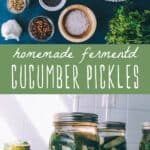
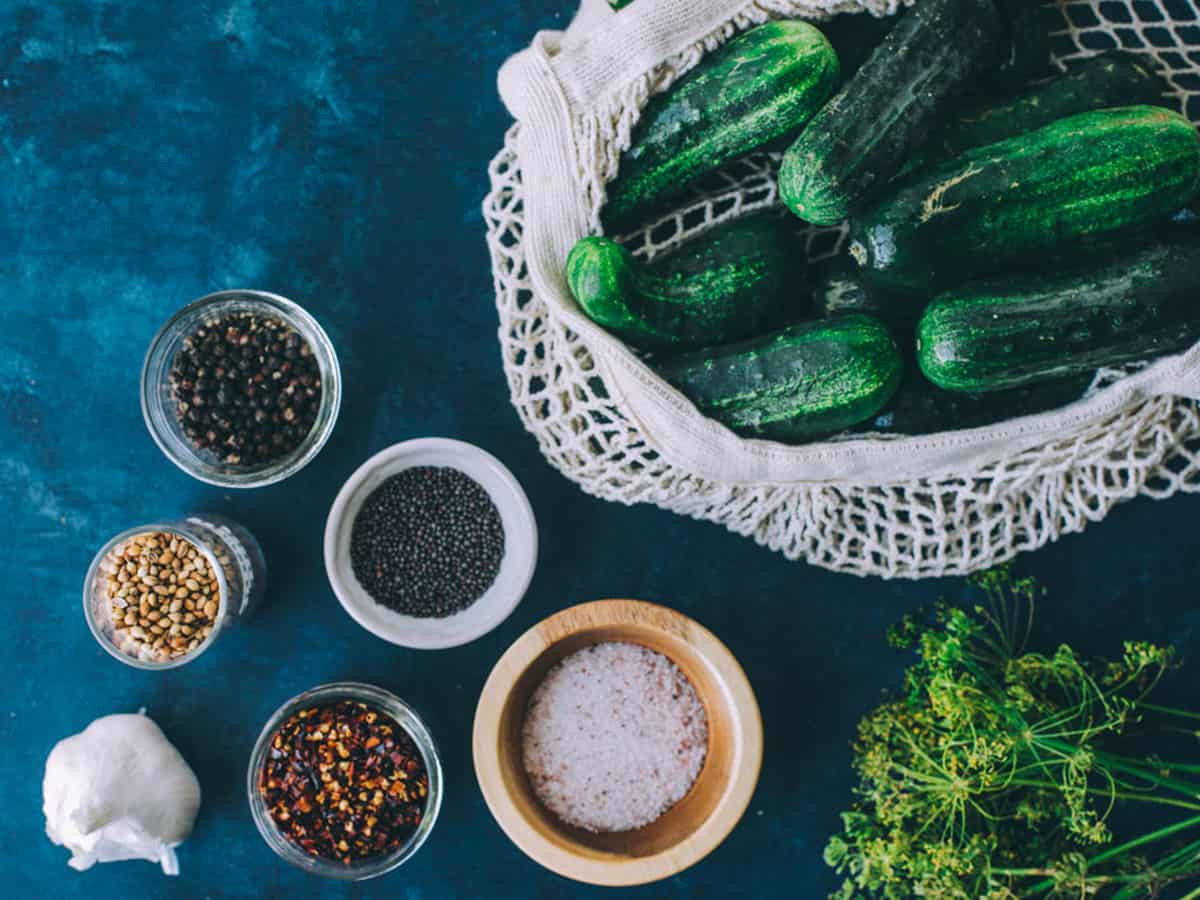
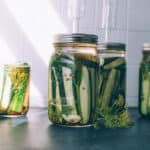

I definitely did not understand that Learnt one thing new today! Thanks for that
Hey, what you wrote about using a smaller jar filled with water and covered with a kitchen cloth, is that the only covering the pickles would need in that situation? I covered mine with a kitchen cloth and tightened an outer ring of a lid on the jars. The water inside is rather cloudy now, 3 days later. Should I have covered it with a lid completely? Or is the cloudiness ok?
Cloudy water in your pickle jar is totally normal and a good thing! It means that there is happy lactic acid bacteria growth and fermentation is coming along nicely!
I have organic Persian cucumbers. I’d like to slice and ferment. Would that work with this recipe?
Thanks!
I haven’t tried, but I’m sure it would be fine.
Is it OK to add Pickle Crisp? My cucumber ferments in the past have turned mushy even with grape leaves added,
Hi Bonnie. I’ve never used it, but a quick search on Google shows that people have used it successfully in fermented pickles.
I find the pickles were very salty.
Hi Ann, if they’re too salty, you can always dilute the brine with more water.
I fermented in a gallon jar, can I now transfer the pickles to smaller jars, top them off with the original brine and store them that way?
Yes, that’s fine!
Planted cuc’s just for this recipe. If I can’t get fermentation lids would it be okay to just leave the lids slightly tightened so that when gas gets built up it can still escape?
Hi Richard. Unfortunately, leaving it open would allow too much bacteria to enter your ferment. You’ll want to screw the lid down completely and then burp (release the built up gases) periodically, at least once a day.
Yes but always keep liquid over the top of the pickles. If you like them buy some fermenting crocks from Wayfair and they have crocks with weights and perfect for fermenting. I used to put a bottle full of water into the mason jar to push down everything and keep the liquid over it all. you can leave the rest open . but watch for bugs or anything like that Always keep liquid over the vegetable so it doesn’t rot out.
Can I ferment sweet onions(sliced)?
Sure!
If I use kosher salt instead of pickling salt can i just grind it to a finer consistency to mimic pickling salt texture?
Hi Laura. That’s fine!
Do I have to cut them or can I leave them whole? Can I use gherkins? Also do I need to add red pepper flakes? Are these in most pickle recipes?I don’t think I want it too spicy
Hi Laura. Yes, you can leave them whole and leave out the pepper flakes if you prefer.
Not sure what I did wrong, but mine are soft light in color and the brine is cloudy now. Did I leave it out of the fridge too long? Does putting in the refrigerator stop the fermenting process? I will try again, but not sure where I went wrong, except leaving them out on the counter too long maybe?
once they look or taste good they are ready otherwise let them ferment for as long as you want. Once you put them in the frig they are done fermenting.
I am so excited to try this recipe! I recently purchased a fermenting crock and already have a batch going in it from a different recipe where the pickles are not speared, they are whole with ends cut off. My question is could I make your recipe using a crock instead? Still using the weights to hold the speared pickles under the brine? Thank you for sharing :)
Hi Melissa. Yes, you can use a fermentation crock. Enjoy!
I’ve been making fermented pickles for several years now with a similar recipe. One thing I learned is that you should always put in a grape leaf, or oak, apple, etc., but if you don’t have any of those a couple of bay leaves will work fine to keep the pickles crunchy. While fermenting, skim off any foam on the top, and if the juice turns cloudy, that’s fine…that usually happens and is the probiotics.
Have you ever fermented or pickled zucchini? Just wondering how it would turn out.
I have. Fermented zucchini pickles are just as good, if not better than cucumber pickles.
How do you slice zucchini? What size works best?
I usually slice them about 1/4″.
I made these recently. It was a month ago, if I remember correctly, and I tasted them last night. They look soft but they are crunchy! I like only one garlic clove and I removed the garlic as they are ‘done’ to me. The garlic isn’t strong like the ones in the store , which I like. I look forward to how they will taste come winter :)
I’m so glad you liked these fermented pickles!
Should you expect to see bubbles when these pickles are fermenting? I am new to fermenting and tried fermenting some tomatoes but never saw any bubbles. After 4 days, one quart smelled bad and the other smelled good. Both developed the kahm yeast but I was too afraid to eat because there were no bubbles, but I’m not even sure if that is supposed to happen in all ferments.
Hi Shonda. There could be noticeable bubbles in this recipe, but every ferment is different. If you were fermenting whole tomatoes, the carbon dioxide likely escaped without you noticing as the gas bubbles had enough room between the foodstuffs to move along unnoticed.
I just made 4 pints of kosher dill pickles. When can I sample one? Thank you.
Give them a taste once they’re paler green in color and a bit softer, but not mushy. Enjoy!
Can these be canned after finished? Or do they all have to go in the fridge
Hi Kim. Since they’re fermented, they shouldn’t be canned so refrigerated for several months is the way to go. Subjecting fermented foods to high heat will kill all the good bacteria that you’ve cultivated in your pickles.
Hi, Colleen, I have a couple of questions. I’ve tried this and similar recipes before but as a couple of the comments mention, I end up with a white mold in the jar. On the sides or on top of the liquid.
I’ve read that it’s not a problem, you can just scoop it off and everything under the liquid is fine. But I’m a little afraid to try.
Am I correct that the mold is fine as long as you scoop it out of the jar?
Hi, Karen. It’s actually not a mold at all, but an aerobic yeast that is formed when there’s no sugar left for the good bacteria to consume causing the pH to drop and lactic acid to form. Skimming it off the top is totally safe and won’t cause you any harm.
I have never fermented before. Will be making this recipe- thanks
You’re welcome, Pauline. Enjoy!
Regular salt and kosher salt are not equal. Kosher is 1/2 as salty. You don’t mention grape leaves or anything with tannins to make them crunch. This does not to justice to someone seriously trying
to make dill pickles.
Using grape leaves is supposed to help keep rhe crunch. It adds a nice flavor.
The tannins in grape leaves keep the pickles crunchy. Use a few bay leaves if you don’t have grape leaves handy.
Just be sure if you buy pickles that they
Don’t have a waxy coating.
Thank you for your detailed recipe! Seeing this done outside and out in the sunlight is a fresh take on a recipe like this one. Usually most pictures are inside, dark, gloomy. Your pictures are colorful, bright, and attractive! I’ll have to give your recipe a try and see if I can pull off the same look and final product you have. I’ve been doing a ton of research on pickling and fermenting to try and make my own products so I don’t have to purchase them from the store any longer. Plus, I will know exactly what is going into my products! Wish me luck!
Please, please, please use ORGANIC cucumbers! Cucumbers are on the list for being one of the most highly pesticided and chemically fertilized crops there is.
After some reading, the white stuff may be a type of yeast not mold.
I tried this, but there was some fuzzy stuff growing around the edge of the jar, not on the pickles or in the water. I had a smaller jar inside the larger jar to weigh things down and where the 2 jars met is where the mold was growing. I guess something went wrong. I only left them 4 days. They smell good, but I are they safe to eat?
I learned fermenting with sauerkraut and worked my way up to pickles. Love them all. But I usually make pickles, green beans, okra, etc… right after a batch of kraut so I can use a little starter brine. I lost a few batches to spoilage, even in a fermenting crock with weights and water-lock lid. Have had much better luck with organic veggies but still an occasional problem without a starter.
Has this ever been a problem for you? I get about 75% success on non-cabbage organic veggies but 100% success with a starter.
This is so yummie!
I’ve been thinking of making fermented pickles. This recipe looks great!
You made this sound so easy ! I haven’t tried fermenting yet cause the instructions are so complicated. I can’t wait to try it now thanks to you. One question, sterilized jars or not ? This is gonna be fun !
Benn fermenting for years and the crocks are the way to go. You can literally ferment anything and the one important thing to remember is always keep liquid over the object you are fermenting. I did beets and carrots and onion in everything and garlic and always organic and if you keep liquid over it just check every week or so and you can taste at anytime. Not hard and do it once and you are a pro!